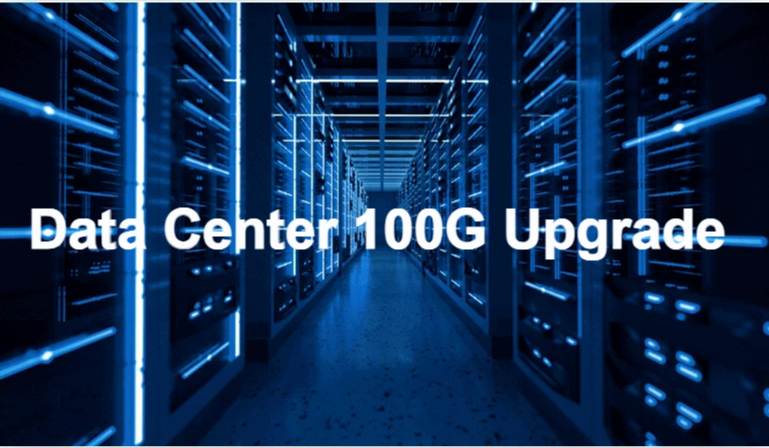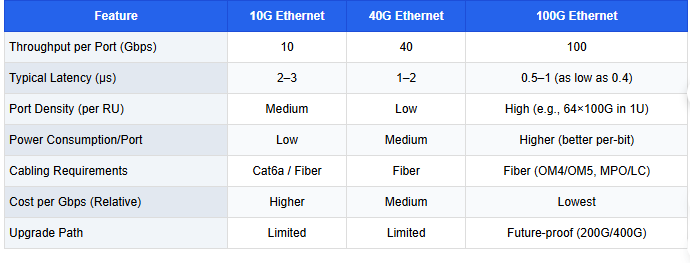In today’s digital landscape, data centers form the backbone of nearly all online activities. The escalating demand for fast, reliable, and scalable network infrastructure—driven by AI workloads, extensive virtualization, and the complexities of hybrid cloud environments—is pushing current network capabilities to their limits. Independent industry assessments forecast a significant 50% to 60% annual traffic growth, necessitating rapid deployment of 100G connections across core, cloud, and edge networks.
This article helps network engineers, IT managers, and data center procurement teams understand when to upgrade to 100G, explore key considerations for selecting 100G switches for data center environments, and plan a smooth, efficient transition.
Why 100G Makes Sense for Modern Data Centers
Traditional 10G and 40G networks are increasingly struggling to keep pace with the massive data volumes characteristic of modern data centers, often resulting in network slowdowns and congestion. A data center 100G upgrade offers substantially increased transmission capacity and reduced latency, significantly boosting data transfer speeds and overall performance.
Key reasons to consider upgrading to 100G include:
- Addressing 10G/40G Limitations with East-West Traffic: The explosive growth of intra-data center (east-west) traffic, driven by AI inference farms, NVMe storage fabrics, and microservice architectures, overwhelms lower-speed networks. 100G networks are designed to handle massive concurrent traffic, reducing congestion and improving efficiency.
- Reducing Oversubscription in Leaf-Spine Designs: High-performance 100G switches are ideal for spine/core layers requiring minimal delay, while advanced switches excel at leaf layers and cloud-scale fabrics requiring dense routing and tenant isolation.
- Enhanced Power and Cost Efficiency: Consolidating multiple 10G links into a single 100G channel improves power-per-bit efficiency and reduces operational expenses.
-
Real-World Application Drivers:
- AI/ML clusters and HPC environments demanding ultra-low latency and high throughput.
- High-density virtualization and multi-tenant cloud workloads requiring VXLAN EVPN support.
- Latency-sensitive applications like high-frequency trading relying on 100G’s minimal delays.
Signs Your Business Is Ready to Upgrade
Knowing when to upgrade can prevent costly network bottlenecks. Key technical indicators include:
- Core Links Exceeding 70% Utilization at Peak.
- Increasing Latency and Jitter Across Racks.
- New Servers Demanding Faster Uplinks.
- Cost Efficiency of Consolidation over multiple 10G/40G links.
Choosing the Right 100G Switches for Your Data Center
Selecting appropriate hardware is vital for long-term success. Consider the following:
- Performance (Chipset and CPU): Look for advanced ASICs like Marvell Teralynx 7 for ultra-low latency and high throughput; Falcon-based switches for cloud fabrics with expansive routing tables.
- QSFP28 Port Flexibility: Supports 100GbE, 50GbE, 25GbE, with breakout capability.
- Compatibility with Existing Fiber and Cabling: Validate single-mode/multi-mode fiber readiness.
- Power and Cooling Requirements: Opt for efficient thermal design and green transceivers.
- Network Operating System (NOS): Consider open NOS options like SONiC or Cumulus Linux.
- Vendor Support and Models: Cisco, Arista, Juniper, and emerging vendors like Asterfusion, NVIDIA Mellanox.
-
Use Cases:
- Spine/Core: Ultra-low latency and congestion management.
- Top-of-Rack/Leaf: High routing capacity and scalable fabric support.
For additional insights on selecting 100G switches and exploring solution options tailored for modern data centers, you can visit our comprehensive data center 100G solutions page for more information.
Real-World Industry Case and Business Benefits
In industries like financial services and HPC, data centers face network bottlenecks with massive, real-time transactions. Traditional 10G or 40G networks struggle to meet TB-level exchange demands, causing slow transfers and performance issues.
Case Example: A data center upgrading from Mellanox SB7700 InfiniBand to 100G Ethernet switches powered by Marvell Teralynx 7 ASICs (e.g., Asterfusion CX-N series) implemented:
- Ultra-low latency hardware with sub-microsecond delays.
- RoCEv2 for lossless, CPU-bypass data transfer.
- Open NOS (SONiC) for flexibility and support.
- Flexible port configurations with legacy speed compatibility.
- Advanced thermal design for reliable operation.
Performance testing showed significant latency reductions and throughput improvements with cost savings of up to 50% compared to specialized InfiniBand, while reducing power and operational expenses.
Common Challenges and Solutions for 100G Upgrades
Challenges include high initial costs, deployment complexity, compatibility issues, increased power demands, RoCE/RDMA complexity, and limited monitoring. To address these:
- Choose open Ethernet switches with RoCEv2 support.
- Conduct thorough fiber audits and upgrade cabling as needed.
- Select energy-efficient, hot-swappable devices.
- Leverage open NOS for automation and ease of management.
- Use TAPs and advanced telemetry for monitoring.
Future Network Trends and the Role of 100G
The future points to 200G, 400G, and 800G Ethernet driven by AI, big data, and real-time applications, with SDN and automation enabling flexible management.
100G upgrades lay the foundation for:
- Transitioning to higher-speed Ethernet.
- Adopting open networking OS (SONiC, Cumulus).
- Integrating automation tools (Ansible, Python scripts).
- Deploying RDMA technologies for HPC and AI workloads.
- Protecting investments with modular spine-leaf scalability.
Evaluation Guide for Data Center Decision Makers
IT leaders should evaluate:
- Core link utilization consistently exceeding 50%-70%.
- Latency increases impacting critical applications.
- Business growth requiring scalable infrastructure.
- Operational costs and downtime from aging hardware.
- Total cost of ownership balancing investment with long-term savings.
If these align, a 100G upgrade is a strategic imperative.
FAQ: Common Questions About 100G Upgrades
Q1: What is a 100G Ethernet switch and why should I care?
A: It offers 100 gigabits per second throughput, boosting speed and efficiency essential for AI and big data workloads.
Q2: What should I look for when selecting 100G switches?
A: Look for low-latency ASICs, QSFP28 flexibility, energy efficiency, open NOS, and reliable vendor support.
Q3: Is upgrading to 100G expensive?
A: While initial costs are higher, long-term savings come from simplified infrastructure and reduced operational costs.
Q4: Can 100G switches work with my existing network?
A: Many support backward compatibility with 40G/25G/10G and offer port breakout for smooth integration.
Q5: What performance improvements can I expect?
A: Up to 10x throughput increases, latency reductions to hundreds of nanoseconds, and improved stability.
Conclusion
Upgrading to 100G is more than just increasing bandwidth; it is a strategic move to future-proof your data center for AI, cloud, and east-west traffic demands. By identifying the right upgrade timing, selecting appropriate hardware, and planning migration carefully, businesses can achieve smoother transitions, enhanced performance, and long-term operational savings.
Ready to move forward? Check out our step-by-step guide on how to build a 100G data center for practical architecture examples, cabling strategies, and equipment selection tips to confidently start your upgrade.






